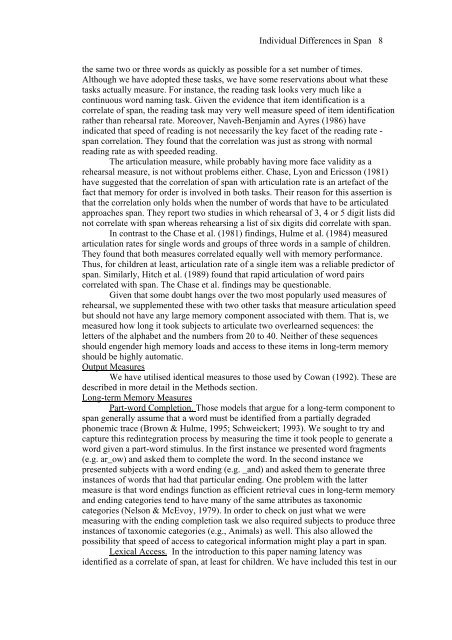Individual Differences in Span 1 Individual Differences in Memory ...
Individual Differences in Span 1 Individual Differences in Memory ...
Individual Differences in Span 1 Individual Differences in Memory ...
You also want an ePaper? Increase the reach of your titles
YUMPU automatically turns print PDFs into web optimized ePapers that Google loves.
<strong>Individual</strong> <strong>Differences</strong> <strong>in</strong> <strong>Span</strong> 8<br />
the same two or three words as quickly as possible for a set number of times.<br />
Although we have adopted these tasks, we have some reservations about what these<br />
tasks actually measure. For <strong>in</strong>stance, the read<strong>in</strong>g task looks very much like a<br />
cont<strong>in</strong>uous word nam<strong>in</strong>g task. Given the evidence that item identification is a<br />
correlate of span, the read<strong>in</strong>g task may very well measure speed of item identification<br />
rather than rehearsal rate. Moreover, Naveh-Benjam<strong>in</strong> and Ayres (1986) have<br />
<strong>in</strong>dicated that speed of read<strong>in</strong>g is not necessarily the key facet of the read<strong>in</strong>g rate -<br />
span correlation. They found that the correlation was just as strong with normal<br />
read<strong>in</strong>g rate as with speeded read<strong>in</strong>g.<br />
The articulation measure, while probably hav<strong>in</strong>g more face validity as a<br />
rehearsal measure, is not without problems either. Chase, Lyon and Ericsson (1981)<br />
have suggested that the correlation of span with articulation rate is an artefact of the<br />
fact that memory for order is <strong>in</strong>volved <strong>in</strong> both tasks. Their reason for this assertion is<br />
that the correlation only holds when the number of words that have to be articulated<br />
approaches span. They report two studies <strong>in</strong> which rehearsal of 3, 4 or 5 digit lists did<br />
not correlate with span whereas rehears<strong>in</strong>g a list of six digits did correlate with span.<br />
In contrast to the Chase et al. (1981) f<strong>in</strong>d<strong>in</strong>gs, Hulme et al. (1984) measured<br />
articulation rates for s<strong>in</strong>gle words and groups of three words <strong>in</strong> a sample of children.<br />
They found that both measures correlated equally well with memory performance.<br />
Thus, for children at least, articulation rate of a s<strong>in</strong>gle item was a reliable predictor of<br />
span. Similarly, Hitch et al. (1989) found that rapid articulation of word pairs<br />
correlated with span. The Chase et al. f<strong>in</strong>d<strong>in</strong>gs may be questionable.<br />
Given that some doubt hangs over the two most popularly used measures of<br />
rehearsal, we supplemented these with two other tasks that measure articulation speed<br />
but should not have any large memory component associated with them. That is, we<br />
measured how long it took subjects to articulate two overlearned sequences: the<br />
letters of the alphabet and the numbers from 20 to 40. Neither of these sequences<br />
should engender high memory loads and access to these items <strong>in</strong> long-term memory<br />
should be highly automatic.<br />
Output Measures<br />
We have utilised identical measures to those used by Cowan (1992). These are<br />
described <strong>in</strong> more detail <strong>in</strong> the Methods section.<br />
Long-term <strong>Memory</strong> Measures<br />
Part-word Completion. Those models that argue for a long-term component to<br />
span generally assume that a word must be identified from a partially degraded<br />
phonemic trace (Brown & Hulme, 1995; Schweickert; 1993). We sought to try and<br />
capture this red<strong>in</strong>tegration process by measur<strong>in</strong>g the time it took people to generate a<br />
word given a part-word stimulus. In the first <strong>in</strong>stance we presented word fragments<br />
(e.g. ar_ow) and asked them to complete the word. In the second <strong>in</strong>stance we<br />
presented subjects with a word end<strong>in</strong>g (e.g. _and) and asked them to generate three<br />
<strong>in</strong>stances of words that had that particular end<strong>in</strong>g. One problem with the latter<br />
measure is that word end<strong>in</strong>gs function as efficient retrieval cues <strong>in</strong> long-term memory<br />
and end<strong>in</strong>g categories tend to have many of the same attributes as taxonomic<br />
categories (Nelson & McEvoy, 1979). In order to check on just what we were<br />
measur<strong>in</strong>g with the end<strong>in</strong>g completion task we also required subjects to produce three<br />
<strong>in</strong>stances of taxonomic categories (e.g., Animals) as well. This also allowed the<br />
possibility that speed of access to categorical <strong>in</strong>formation might play a part <strong>in</strong> span.<br />
Lexical Access. In the <strong>in</strong>troduction to this paper nam<strong>in</strong>g latency was<br />
identified as a correlate of span, at least for children. We have <strong>in</strong>cluded this test <strong>in</strong> our
















